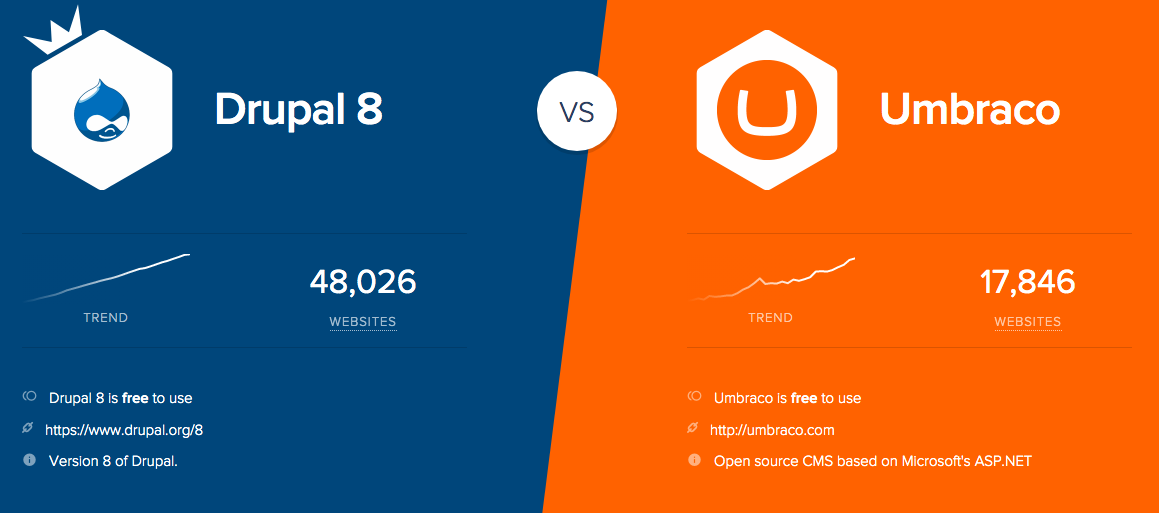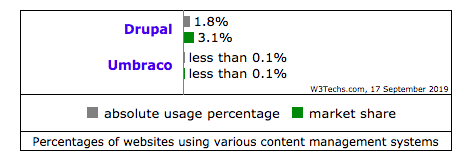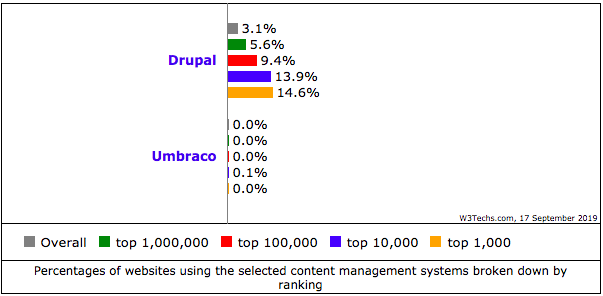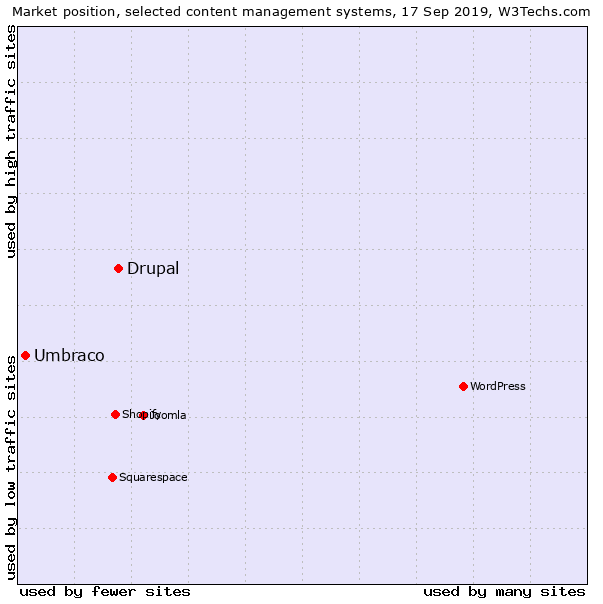Like every organization, you want yours to build around consistent and successful marketing operations. The choice of your CMS has a lot to do with the execution of successful marketing campaigns.
Dynamic organizational goals need dynamic sites. Which raises the bar high when selecting the CMS of your choice. But, it comes along the cost involved in all aspects.
In the comparison series, today, we have Drupal (open source software) vs Umbraco (proprietary software).
Here’s to choose between Drupal and Umbraco. Which one serves your needs better? Read on to know more.

Significance of Content Management System (CMS)
Do you own a content website and its management is becoming a task? With hundreds of content pages on hand, the need for an efficient approach becomes imperative.
And a Content management system is exactly what you need.
From Drupal to Wordpress, there are various CMS platforms that have business benefits and provision your website with features that make your blog and content creating tasks easier. The CMS is designed to maintain the website and enhance your overall experience with content scalability. A well-deployed CMS aims to manage the employee contributions and support the online reach of your content.
It is primarily used by corporate, news, and e-commerce websites for a smooth flow of content and its administration.
The big decision-making question hangs with the plethora of CMS options available in the market. Deciding which CMS to pick depends on a lot of factors from the requirements to the features offered at the table.
Market Share of Umbraco vs Drupal 2019



Drupal has better usage coverage in more website categories. Including Business & Industry, Arts & Entertainment, People & Society, Career & Education, and 242 other categories. In other words, Umbraco hasn't got a lead over Drupal in any websites category.
Let’s get to the actual comparison.
Round One: The Cost

Umbraco is an open source software built on top of Microsoft’s .NET Framework. Umbraco is a completely free, opensource content management framework.
Umbraco add-ons range from free to a licensing fee either per domain, per server, or a lifetime license. The licensing is covered under MIT license which means you can do whatever you want as long as you include the original copyright and license notice in any copy of the software/source.
But as one of the people writes in one of his answers “Umbraco as a core product is free and the cost of the website depends on how much time it will take you to build the website...you need to include the cost of spending money on commercial add-ons”.
Drupal, on the other hand, is also an open source software. Free to use, re-use, and distribute. Drupal modules (add-ons) are free too.
The Drupal.org (official Drupal website) writes it as “...It's built on principles like collaboration, globalism, and innovation. It's distributed under the terms of the GNU General Public License (GPL). There are no licensing fees, ever. Drupal will always be free.”
It's a tie!
Round Two: Editing Experience
At the heart of marketing lies content.

A marketing CMS streamlines the work involved in creating new content in unprecedented ways. That is why your CMS needs to offer the right and intuitive kind of editing experience.
Creating content is easy in Drupal. Authoring with WYSIWYG features is designed to keep content creation neat and ordered. It provides the preview and drag-and-drop image uploads option. And when you need to make quick changes with in-context editing it is easier.
Not just this, it is available in 100 languages. You don’t have to limit your audience to one specific demography or language.
With the help of a CKEditor feature built specifically for Drupal, you can more easily control details like image alignment and captions right from the palm of your hand.
By default, the editor enforces clean markup and has formatting tools disabled. In case you are looking to change the settings or editing buttons you just need to use a drag-and-drop configuration UI for adding and removing editor buttons.
Editing is indeed intuitive in Umbraco.
It is easier to just add the content and rearrange it accordingly. Working on Drupal’s text editor for more than a year, it has been a breath of fresh air (no offense, Drupal community). Adding multimedia content is easy.
Not just this, you can also see the preview of your content on different sites with Umbraco’s unique Responsive Preview. Even before it is live.
This ensures that the visitors experience the content the way you want them to. Adjustments are easy to make too.
Another thing that adds is that as an editor you can always roll back to an older version. It’s like an infinite undo button. (@Drupal we need this.)
The built-in Umbraco Image Cropper ensures that your images are presented as you want. With the focal point, you simply point and click on the most important thing in the image and the image is automatically resized and cropped to fit perfectly on any device while ensuring that the most important thing stays in focus.
Drupal’s Focal Point module promises similar functionality but it needs to be added later.
Both offer the option to schedule the content.
Umbraco Wins!
Round Three: Practicing Accessibility

It is very important that as an organization you don’t happen to miss any of your audience, not even by ignorance.
Drupal 8 provides web accessibility out-of-the-box and it is mandatory. Not just this you could even mark content regions with attributes with HTML5 semantic markup.
Navigation is simpler by identifying menus, banners, and ancillary content areas, and letting keyboard users move through them more easily. Drupal 8 puts these methods to work in a new admin toolbar that adapts to different screen widths and is easier for people with screen readers to use.
Umbraco, although, provides accessibility features like alt text sadly they are optional. Accessibility is something that should be part of the general web development practices, and Drupal ensures the discrimination doesn’t happen, as a choice.
Drupal Wins!
Round Four: Community Support
The Drupal Community is one of the largest open source communities in the world. The community support involves documentation creation, sharing networking opportunities, and more. The sheer commitment to the open source spirit pushes the Drupal project forward.
Around 1,300 agencies provide Drupal services across the globe (according to Drupal.org) and more than 3,200 contributors are working right now to improve the platform.
Community support of Umbraco is no different. The official website tells us that they currently have an active community of over 200,000 “Umbracians” worldwide ready to share their experience and knowledge with others.
They take pride that the online community transcends to and becomes real gatherings all over the world in the form of local Umbraco meetups and even Festivals.
It’s a Tie!
Round Five: Installation Profile

Getting started with the Umbraco? It provides you with two options - the Clean website and the one with a demo. However good the intentions were a clean slate can be a bit overwhelming for some, especially if they’re new to Umbraco.
Drupal - the latest 8.6 version provides a starter kit - a basic site with a sleek minimalistic design of a food magazine. Learn and play with it. Set the features as you want.
This makes it easy to customize and see how Drupal features set in. See if it fits your needs.
Drupal Wins!
Round Six: Headless/ API first

An API first or Headless CMS simply lets you hit publish and your changes will automatically update on mobile apps, on store displays, flat screens, websites, even on smartwatches.
A feature that you can’t afford to miss especially when there are numerous screen types today.
Umbraco promises that it's headless “helps you edit the content easily in one place, and it is updated across your webshop, website, campaign sites and on displays on every screen.”
Umbraco Headless helps you enable power for other types of websites with Umbraco such as Single Page Application or websites running on a different platform than .NET.
Problem?
The community is very close to having everything in place for the official launch of Umbraco Headless. It is not yet launched. All Hype, Nothing Fruitful
Drupal 8 core has out-of-the-box REST API that allows operators to interact with content entities like taxonomy terms, nodes, users, and comments.
Drupal 8 has Contenta (a Drupal distribution) and Reservoir, two of the API-first initiative. Various contributed modules allow you to add web services to a Drupal installation without the need for writing code.
For instance, Developers can use the Services module and the RESTful Web Services module to configure a server for enabling the Drupal installation to push or allow data that is to be pulled as needed with the help of REST API. No matter whether the action is a push or pull, Drupal is the services layer.
Drupal Wins!
Round Seven: Training and Understanding

Umbraco.TV will help you go from zero to Umbraco hero at a pace that suits you. The easy to follow online training videos + written docs will give you the fundamental knowledge to start building awesome Umbraco websites, without burning a hole in your pocket.
Drupal has a steep learning curve. True that!
But the content is easily available on the web. You can access learning material on Acquia, OSTraining, and Drupalize.me. Leaving Drupalize.me aside both the sources are free and available for all.
It’s a Tie!
Round Eight: Hosting and Deployment
Drupal is hosting-service agnostic which can be deployed to any hosting service that supports PHP-based web applications. It stores the site configuration data in a consistent manner. It is easy to move configuration between environments like development, test and production environments.
Umbraco solutions are typically hosted by Microsoft Azure. To aid in deployment to Azure, Umbraco comes with an Azure toolkit consisting of ready-to-run command scripts, performance optimization configurations, security essentials and many more.
Being hosting-service agnostic, Drupal does a better job in this category.
Drupal Wins!
Round Nine: Community
Apart from a good market share in major countries, the Drupal community is active in major countries like United States, Russia, France, Germany and more.
However, the Umbraco community doesn’t stand tall against Drupal with major presence only in the Netherlands, UK, and Denmark.
Drupal Wins!
Round Ten: Navigation and Accessibility
In the increasing competition among the CMS platforms, each one is offering the best of features. Navigation and accessibility are two major traits that the organizations are seeking from their CMS.
Drupal 8 offers out of the box web accessibility to its users and characteristics like easy adaptation to different screen widths, navigation that identifies the banners, content areas, and menus.
On the other end, Umbraco has accessibility as an option but not as a feature. It lacks to address a few pain points and thus, Drupal becomes the winner here.
Drupal Wins!
Drupal vs Umbraco Comparison
|
Features |
Drupal |
Umbraco |
|
Cost |
OpenSource, Free to use |
OpenSource; Free to use |
|
Editing |
WYSIWYG CKEditor |
Intuitive editing |
|
Accessibility |
Mandatory |
Not Mandatory |
|
Community Support |
Worldwide community support |
Worldwide community support |
|
Installation profile |
With content |
Without content |
|
Headless Initiative |
Architecture is supportive of Headless |
Doesn't support headless architecture |
|
Training and Understanding |
Learning material on Acquia, OSTraining, and Drupalize.me |
Umbraco TV |
|
Hosting |
Works well with any hosting service that supports PHP-based web applications |
Typically hosted by Microsoft Azure |
Conclusion
Every CMS has its own set of advantages. The choice of CMS is generally influenced by what your web project’s requirements are. The questions that follow are: What functionality or features are needed?
In my opinion, Drupal has a bonus point for maintaining a modules directory that lets you search and manage the content.
It's easier to customize components—views, lists, blocks, admin tools, and more—than ever before. Control how data is displayed without using a single line of code.
Drop us an email at [email protected] to discuss your business goals.
Do not forget to follow us on Facebook, Twitter, and LinkedIn!
Subscribe
Related Blogs
Inside the Drupal AI Summit: Themes, Speaker and What To Expect

“ The web is changing fast, and AI is rewriting the rules. It writes content, builds pages, and answers questions directly,…
FOST and Drupal AI Initiative: Next Era of Responsible AI

Three years after the launch of generative AI tools marked a new age for artificial intelligence, almost 90% of survey…
Drupal AI Ecosystem Part 5: AI Content Suggestions

Drupal has steadily evolved from being just a content management system into a flexible platform that incorporates emerging…




